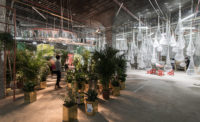A different journey acts as the catalyst for an exhibit called Breakwater by Rafi Segal, Yonatan Cohen, Maayan Strauss, and Savina Romanos, This one involved a three-week sojourn by Strauss on a cargo ship plying the Mediterranean and set her to thinking about the way old trade routes both unite and separate port cities and nations.
Across the border in Hong Kong, the other half of the biennial centers on an exhibition called Beyond the Urban Edge: The Ideal City? Chief curator Colin Fournier has installed the show in part of a still-active ferry terminal in the Kwun Tong neighborhood and in an adjacent waterfront park, as well as on a site near another terminal on the other end of the ferry line. An industrial area where artists—especially musicians—have been able to find inexpensive studio spaces, Kwun Tong is now targeted for redevelopment. Plans to turn it and the surrounding East Kowloon area into a new central business district have alarmed many local residents, some of whom turned out on December 11 to protest the opening of the biennale and to heckle Hong Kong’s Chief Executive C.Y. Leung. For these people, the most important border wasn’t the fixed one with China, but an unstable one with its wealthier, local neighbors.
To his credit, Fournier—who had directed the graduate program in urban design at the Bartlett School of Architecture in London and is now a visiting professor at the Chinese University of Hong Kong—welcomed the protesters and said he hopes the biennale “serves as a platform for the exchange of ideas from different groups.”
Engaging the public is a critical part of Fournier’s program. In the Kwun Tong terminal, he and his team of curators (Joshua Lau and Allen Poon of Tetra Partners and Tat Lam and Travis Bunt of Urbanus) installed dozens of small exhibits on two floors. Visitors to the biennale enter the building the same way as people heading for the ferry and an old metal-mesh fence separating the two functions allows everyone to see what’s happening on the other side. To emphasize the role of debate, Fournier and his team set up a mah jong table near the entrance to the biennale where people can sit and discuss critical issues.
Exhibits in the building look at a range of topics, including hyper-density, the flora and fauna along the rail line linking Hong Kong and Shenzhen, urban villages, and water purification. Outside, in the slender park that runs along the waterfront and underneath a highway, a group of installations includes a giant video wall set up by the city of Barcelona and a structure shaped like a fish trap that’s made of salvaged shipping-pallet pieces. Designed by artist Kasey Wong, the pavilion displays books banned by the Chinese government, such as works by artist Ai Weiwei and Liu Xiaobo, a literary critic who won the 2010 Nobel Peace Prize and is in jail in China.
“Change usually happens at the edge,” says Fournier. “But sometimes it takes place at the center, as is happening now in Kwun Tong.” He also warned that, “As they grow, cities do a lot damage to the environment and sometimes to people living in them.” So he asked all of the roughly 80 participants in his part of the biennale to imagine what cities could or should be and to write a short text and present one image answering the question: What is the ideal city?
In recent years, change has been one of the few constants in Chinese cities and society. Hundreds of millions of people have migrated from rural areas to cities, transforming these places at a pace and scale unimaginable before. How China handles the next stage of its radical national makeover will affect the world’s environment, economy, politics, and culture. Architects and planners don’t have the power to dictate a new direction, but they can at least inform discussions and debates swirling around the eye of the urban storm. In its own small but provocative way, the Bi-City Biennale contributes to this public dialogue.
The Shenzhen Hong Kong Bi-City Biennale of Urbanism\Architecture runs through February 28 in Shenzhen and February 23 in Hong Kong.























Post a comment to this article
Report Abusive Comment